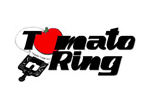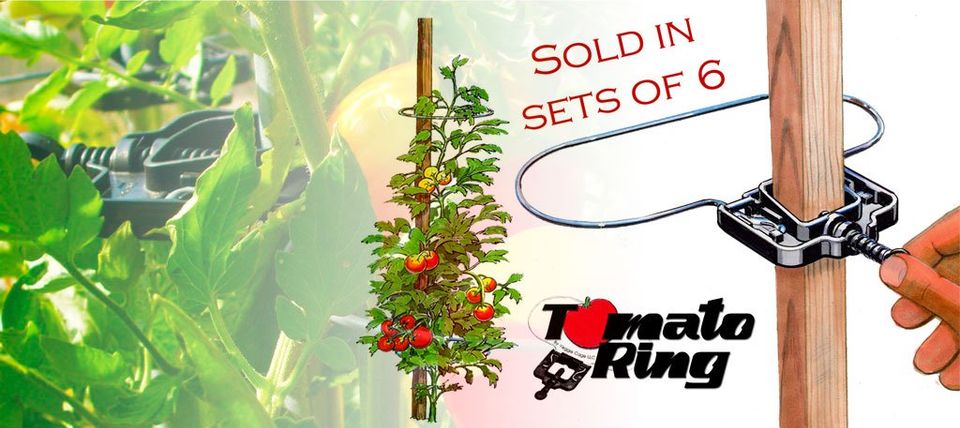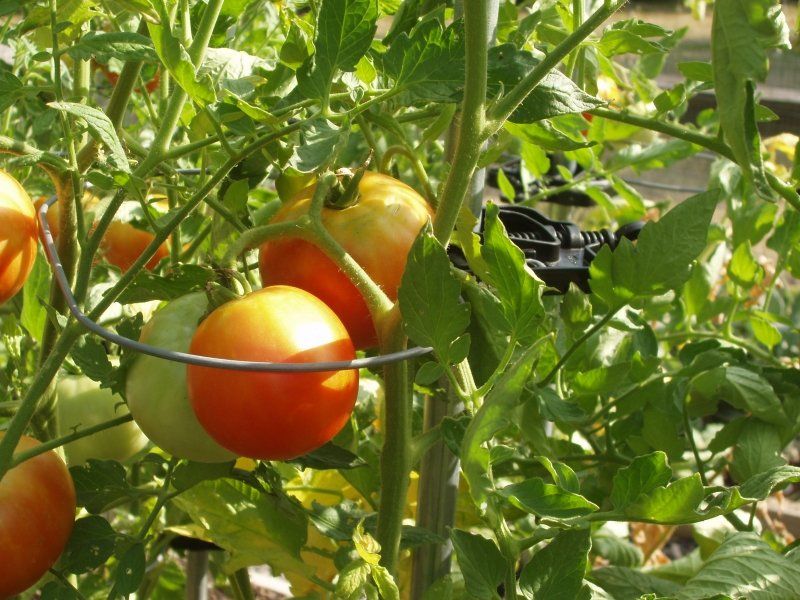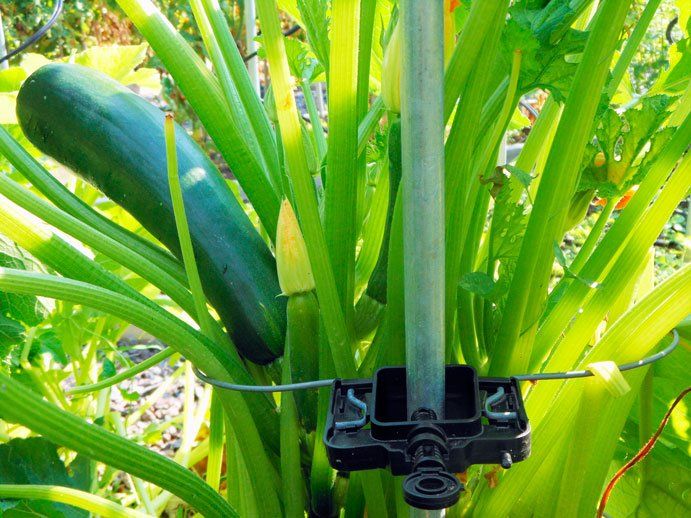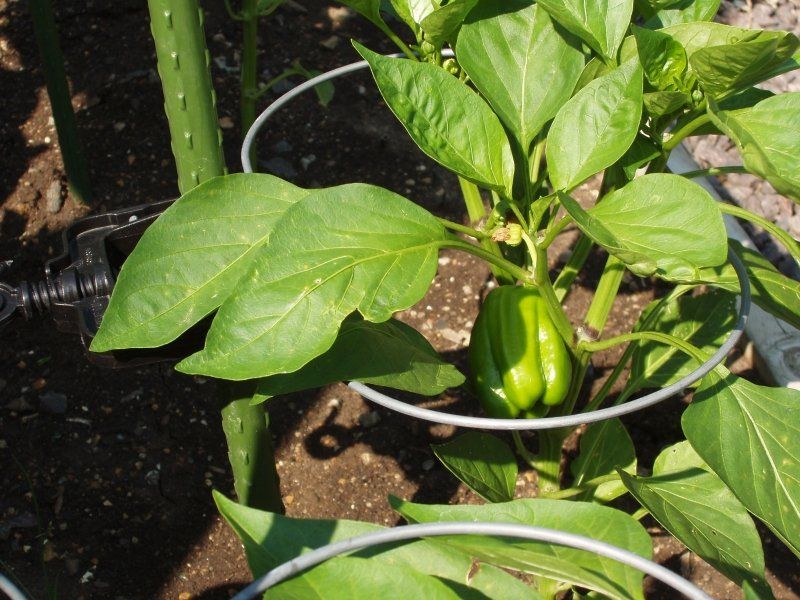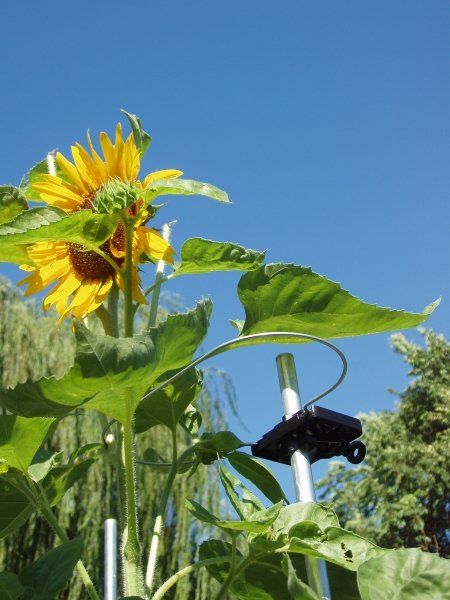Tomatoes
Tomatoes are easy to grow with the tomato ring. No tomato cage needed!
Zucchini
No tomato cage needed, the tomato ring makes growing zucchini a piece of cake.
Peppers
The Tomato Ring is also perfect for growing a variety of peppers
Sunflowers
The Tomato Ring can even handle the tallest sunflowers.
- Starting An Early Spring Garden
After a long winter, most of us are ready to see some color again. Spring is approaching quickly, so now is the time to start getting ready for your spring garden. Here are some of our favorite things to plant for an early spring garden. For urban gardeners working with a small footprint, many of our spring favorites are great for small spaces.
For a beautiful window sill setup or kitchen garden:
Radishes, lettuces, and spinach can add a touch of life in a window box or planter. With a variety of different lettuces, you can add lots of colors to your windowsill planter.
Herbs offer a selection of different textures and flavors that you can use in salads or for cooking in your kitchen. Add a wonderful fragrance to your home with some of the smaller herbs in the windowsill. The larger herbs should be planted in a large pot or directly in the ground as close to the kitchen as possible. The closer they are to your kitchen, the more you will use them!
- Sweet marjoram offers a mild and sweet pine and citrus flavors and has smooth leaves.
- Chives add a zesty flavor to salads or can be used as a garnish. Planted in the ground, these are an easy perennial plant that adds edible greenery to your kitchen garden.
- Parsley has a bright green color with yellowish-green flowers and offers a tangy taste and can be used as a garnish on almost any meal.
- Oregano is a must-have for Italian dishes and has purple flowers and spade-shaped, olive-green leaves.
- Basil offers fragrant spicy leaves and has small white flowers. Basil can be kept small in a pot or window sill planter or can get 2-3 feet high when planted in the ground. If you plant too much basil, make pesto!
- Dill has white to yellow flowers and goes great with fish dishes and soups. Dill can grow several feet high, so best to grow in the ground or a large pot.
Spring veggie favorites:
- Peas are great for a spring garden, and they can even handle light frosts. You can start these inside and plant out as soon as soil can be worked, but we prefer to start them in the ground.
- Beets grow well in cool weather, making them great for a spring garden. They also transplant very well, so you can easily move them out into the garden as soon as the soil dries out in the spring. Give these a sunny spot.
- Start broccoli now if you want to harvest before summer. For best results, look for a quick-growing variety.
- Celery is a cool-weather crop – ideal for a spring garden. The secret to success is getting an early start, as celery needs a few months of cool weather to come to harvest. Go ahead and start some seeds indoors now.
- Sow hot peppers and sweet peppers indoors now. The seeds need warm temperatures to germinate. Peppers are great because they take up little space, producing high yields when planted close together.
- Vertical Gardening - Taking It To The Next Level
Lack of space is one of the top reasons that people don’t have their own garden. If you lack space, try vertical gardening. With our products and helpful tips, you can add some natural beauty and life to your home by efficiently using a small footprint for your garden.
Vertical gardens are rising in popularity, so many different variations of trellises, hanging pots, and wall hangers are available on the market to help you get started.
Our Tomato Ring is the ideal plant support for a variety of plants. Designed specifically for growing tomatoes and made of galvanized spring steel, the Tomato Ring is also great for many other types of flower or plant that tend to flop over without a little plant support. The Tomato Ring requires only a small space for off-season storage.
- Tips For Successful Seed Starting
Starting seeds is fun and easy. There are different stages to starting seeds and each stage requires different care. The most important thing throughout is to keep a close eye on the seeds – don’t forget about them and check them daily!
Here are some more tips for a successful seed starting endeavor.
Getting Started – Growing Medium, Containers, and Sowing
Timing:
Getting the timing right is relative to the last frost date for your area and the specific variety you are growing. All plants are different, so check the seed packet to find out how many weeks each variety will take to get ready indoors before your last frost date. Tomatoes, eggplants, and peppers do best when sown 6 weeks before the last frost date.
Growing medium:
Just like all babies, seedlings are very delicate. Start them off with a better chance for success by sowing them into a fresh seed starting mix. Check out our tips making your own seed starting mix. A good seed starting mix has to be light and fluffy to hold just enough moisture. A mix that is too dense prevents the fine new roots from growing and pushing through.
Containers:
- Pick a container. This part is pretty easy – as long as the container you choose is clean and sterile and 2 or 3 inches deep, it should work just fine. We like to re-use plastic yogurt or sour cream containers.
- Check for drainage. If your container doesn’t come with holes, punch some holes into the bottom of containers so excess water can drain away.
- Put it on a waterproof tray. Get a shallow saucer, plastic lid, or waterproof tray to put the containers in.
Sowing:
- Put your growing medium into the containers and moisten it before sowing the seeds.
- Plan ahead and give the seeds room to grow. Put the seeds on the surface of the growing medium, spacing them apart, giving them the room they need.
- Start sowing the seeds at a depth about three times the thickness of the seeds. However, some seeds should not be buried, so double-check the seed packet to see if they need light to germinate.
- Cover the containers. This helps retain moisture and hold in humidity while the seeds germinate. You can use a plastic bag loosely fastened to the top of the container.
Germination
Warmth is crucial for successful germination. Put your seeds somewhere with a gentle heat, like on top of your refrigerator, air vents, or dryer, or prop them a few inches above a radiator.
Seedlings and the Growing Stage:
- Once the seeds have sprouted to about half an inch tall, uncover the containers. Air circulation is important now.
- Pour water into the trays to water them from the bottom. Do not pour water directly on top of the sprout. Make sure air circulates freely so humidity isn’t trapped around plants.
- Move them from their warm spots and into the light. Seedlings don’t have to stay as warm as germinating seeds, so average room temperature is better for seedlings. Move them to a sunny window, a greenhouse, or beneath a couple of ordinary fluorescent shop lights. If you’re using grow lights, make sure to keep the light suspended about 3 inches above the plants and gradually raise them as the seedlings mature.
- Teach them to be strong. Lightly petting your seedlings can help them grow stronger and stockier. You can also set up a fan to gently, continuously blow on your seedlings – this also helps keep the air around them circulated.
Don’t forget to have fun with it! You will be amazed how quickly your delicate sprouts become big, strong plants that can take over your garden if you aren’t careful!
- Tomato Ring FAQs
The Most Frequently Asked Questions
The Tomato Ring is so easy to use, it almost needs no explanation. Still, you might have a question or two, so below are a few of the most frequently asked questions about using the Tomato Ring.
Q: How long will a Tomato Ring tomato support last? Can I use it for more than one season?
A: You can expect your tomato supports to last several seasons, probably 5 to 10 seasons. There is nothing on the Tomato Ring to rust or rot, like typical wire tomato cages. You’ll get the maximum number of growing seasons by taking your Tomato Rings in for the winter.
Q: What is it made from?
A: The Tomato Ring is made from galvanized spring steel and is molded from lasting, durable carbon black homopolypropylene, a very dense material, designed to withstand weathering from the onslaught of sun, wind, and rain.
Weight, Uses, Plant Concerns & More:
Q: Is any assembly required before I can use it?
A: No. The Tomato Ring comes all in one piece. You need only to snap off the threaded thumb screw and screw it into the clamp in order to hold the Tomato Ring to your tomato stake. No other assembly is required.
Q: What kind of tomato stake will I need for this?
A: Any kind of tomato stake will work with the Tomato Ring tomato cage: round, square, wooden, or even metal rebar rods, which some people like to use. Our favorite is ¾ electrical conduit. You can buy them in a 10ft length at a local hardware store and have them cut 3ft of one end so you could use to support your peppers, eggplants, etc. Your remainder 7ft will be used to support your tomato plants. The clamp dimensions are 1-3/4″ X 1-3/8″. Any stake that will fit within that space is perfect for the Tomato Ring.
Q: How big around is the Tomato Ring?
A: Tomato supports measures approximately 5 3/4″ X 10 5/8. If this sounds surprisingly narrow, remember the Tomato Ring is only capturing the tomato plants stems.
Q: How much does it weigh?
A: About 3/8 lb.
Q: How tall will the Tomato Ring reach?
A: Your height restriction is only limited by the length of your stake. We recommend at least a 7ft stake. However, it can also be used at a lower height, depending on the height of the plant you’ll be using it for. For instance, you may want to support peppers, eggplants, dahlias, etc. Those only need a 3ft stake.
Q: How do I store the Tomato Rings?
A: The best way is to just hang them on your garage wall are just toss them in a bucket.
Q: What other plants can I grow using the Tomato Ring plant support?
A: There are so many! For instance, you could support peppers, eggplants, zucchinis, dahlias, etc.
Q: Won’t the weight of the tomatoes or the whole plant bend the ring?
A: Not at all if you follow our directions. We tell our clients to keep the top ring no more than 12inches from the top of your plant. That way The Tomato Ring will never support any weight. It simply keeps the tomato plant from falling over.
Q: Is a stake included with my purchase of Tomato Rings?
A: No, but the Tomato Ring clamp will work with just about any type of stake you buy or may already have.
All Roots Planter Co.(an Accelerated Plastics Company)1574 Madison Ave.New Richmond, WI 54017715-246-7979
info@acceleratedplastics.com
All Roots Planter Co. by Accelerated Plastics LLC. All rights reserved.

